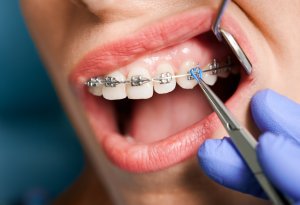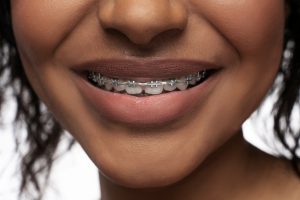Are you interested in straightening your teeth, but the idea of train track braces is putting you off? Well, don’t worry because these days there are plenty of orthodontics options when it comes to braces, and there are plenty of alternatives as well. But first let’s find out more about braces, including:
- What are train track braces?
- How do fixed braces work?
- Types of braces
- Alternatives to train tracks
- How much do braces cost?
There are all sorts of ways to straighten your teeth, and traditional fixed braces are just one of those ways. We will discuss them in detail, as well as alternatives so you have all the information you need to make a decision. You may even end up deciding that train tracks are the right choice for your needs.
Of course, the best person to help you decide on a treatment route is your dentist so always consult them before making your final decision.
What are train track braces?
Train tracks are just another name for traditional braces. It comes from the way braces look when they are attached to the teeth with the archwire running through connecting the metal brackets.
When people think of braces, they think of the traditional metal train tracks teeth look. However, there have been advancements in technology in more recent times which means that they are now smaller, lighter, and more discreet.
They are also suitable for both adults and teens, although braces through Medicaid could be free for children under the age of 18. It is worth checking with your dental practice what the suitable age is for children to start wearing braces if you aren’t sure.


What are train tracks made from?
Fixed braces are made from metal; more specifically stainless steel that is sometimes combined with titanium. The metal brackets that sit on each tooth are then connected by a flexible wire, also made from stainless steel. The archwire is secured by small rubber bands that can come in many different colors.
Bigger rubber bands are also used to help pull teeth in different directions. Sometimes, metal bands (orthodontic bands) are used to gradually move teeth that need stronger pressure into position.
How do train track braces work?
Now that you know what traditional braces are made from, let’s talk about how they work.
Your orthodontist attaches metal brackets to each tooth. The metal wires, known as the arch wires, connect to each one and are secured by small elastic bands.


Braces work when your dentist shortens the wire over time and adds larger rubber bands in certain positions to slowly move your teeth into the desired position.
It can take 1-2 hours to attach the braces to your teeth, and then, depending on the severity of your case, 1 – 3 years to straighten your teeth. Braces treatment time can depend on the type of braces you have, your age, and your individual severity of misalignment.
In cases of misalignment or malocclusion, you may need to wear an orthodontic appliance before your braces which can add up to 12 months to your treatment.
There are some alternatives to braces that have a much shorter treatment timescale if you are eligible for them. You will need to visit your dentist or orthodontist to decide on a suitable option before making a final decision.
How are train track braces fitted?
The following video shows the steps of braces being fitted so that you know exactly what to expect when you get yours.
Types of braces
If you get treatment through Medicaid, generally your only option to improve your smile is train track braces, and the criteria for eligibility are quite stringent. However, if you opt for private treatment there are a multitude of options. So, let’s discuss other types of braces and alternatives.
If you are wondering how to know if you need braces, then read our article to find out more and make an appointment with your dentist or orthodontist.
Ceramic braces
Ceramic braces are a little more discreet than regular braces, although not unnoticeable. This is because the material that they are made from is clear, white, or tooth-colored ceramic, helping them to blend into the teeth behind them. The wires that connect the brackets can also be tooth-colored which helps them to be less noticeable.
Lingual braces
The most discreet fixed braces are lingual braces. This is because the brackets are attached to the teeth facing inward so that they cannot be seen from the outside (unless the mouth is open). They are often difficult to adjust, treatment time takes longer and they can often cause speech problems due to the proximity to the tongue.
This type of braces are much more expensive than traditional braces, and can often have more cons than pros. However, speak to your dentist if you are interested in getting this type of braces.
Self-ligating braces
Self-ligating braces look very similar to traditional fixed braces, but they work quite differently. They are self-tightening and the modern technology of heat-activated wires makes adjustments more steady and gentle.
These braces are made to be more comfortable, easier to adjust, and need no elastic or metal bands to work. The lack of rubber bands also means that they are more hygienic than traditional braces.
Clear braces
Many people think that clear braces are similar to invisible aligners, but what’s the difference? Clear braces are actually just traditional braces that are clear or tooth-colored.
There are not really any similarities between these and aligners like Invisalign other than the fact that they both are used to straighten teeth. Some examples include the following:
- Damon Clear
- Radiance Plus
- Clairty
- InVu
- Quick Straight Teeth
What are some alternatives to fixed braces?
Invisible braces
The alternatives to fixed braces for straightening teeth are clear aligners (invisible braces). Clear aligners are a series of removable clear plastic trays that are custom-made to the shape of your teeth. They fit snugly over your teeth to apply pressure and slowly guide your teeth into the desired position.
Every 2 weeks, the aligners are changed for a new set so that they can continue to align your teeth. There is a varying amount of time that treatment can last depending on which aligner you choose and your individual case. Treatment time can also depend on your ability to comply with wear time.
Many types of aligner treatments come with teeth whitening included with is a bonus. Teeth whitening with braces isn’t always possible, but it is with clear aligners because they are removable.
Invisalign is the most popular and effective clear aligner, but some other examples include:
- ClearCorrect
- Quick Straight Teeth
- Six Month Smiles
- SmileLife
- Dr Smile
Invisible braces, also known as clear aligners are generally used for less complex orthodontic cases. Train track braces are used for more severe cases of misalignment and crooked teeth.
Conclusion
Train track braces, although more traditional and perhaps old-fashioned when compared with modern alternatives are still very effective. In fact, when it comes to more severe and complex orthodontic cases, they are still the best choice.
While train tracks are the only choice if you choose to get treatment through Medicaid (and are eligible), if you get private treatment there are a few options. Both lingual braces and ceramic braces are more discreet than metal braces.
Or, you can always go a bit more flashy and get the train track braces with colors.
If you are still not sure about which braces are for you, book a consultation with an orthodontist to discuss your options further.
Wiley Online Library: Clear aligners in orthodontic treatment. Consulted 4th August 2021.




